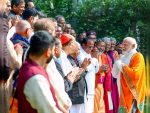Guwahati – In an effort to bridge the knowledge and skills gap between the academia and industry a Guwahati based university teamed up with Ministry of New and Renewable Energy to hold a symposium on 23rd April 2016. Some 80 students and faculty participated.
The department of Electrical and Electronics Engineering, of School of Technology, Assam Don Bosco University, organized a second symposium this year on “New & Renewable Energy Resources” aimed at building the awareness and interest among the students towards renewable energy research. Later this year, the EEE department plans to hold an international symposium on the same topic.
The regional office, Ministry of New and Renewable Energy (MNRE) participated in the symposium.
The chief guest at the symposium Dharma Ranjan Das, Advisor to the Govt. of India, MNRE informed about the different Solar Photovoltaic cell projects undertaken by Govt. of India.
He stated that central govt. has set a target of 165 GW of power to be achieved by the year 2022, out of which 100 GW is to be harnessed from solar energy, 60 GW from wind energy and 5 GW from hydropower.
Further he gave a detailed description on the roof top PV cell projects in India stating, “Rooftop Solar Photovoltaic power plants installed in 1,000 residential buildings in Guwahati are capable of generating 1 MW of power from solar energy every day, which would be very essential to meet the peak load demand of electricity in the city.”
Das underlined the fact that MNRE has launched the scheme of rooftop solar photovoltaic systems with a subsidy of 70 percent on the benchmark cost of the system for the North Eastern region.
“There are 130 million houses with proper concrete roofs in the country with total potential installation of 25,000 MW capacity rooftop solar power plants,” Das said.
Another invited speaker of the program, P. Handique, Retd. CGM, ASEB, enlightened the participants with his informative session, focused on hydroelectric power plants and their concerned socio-economic aspects.
“Hydro-power has the highest potential in North East India compared to any other renewable energy,” Handique said.
He added that, “to eliminate the power scarcity in North East India it is very much important to look into the Hydro power generation.”
He cautioned the audience “without knowing the ground reality and technical background we should not oppose the hydro-electric infrastructure.”
The last talk was delivered by Mr. Jesif Ahmed, Assistant Professor of EEE department where he gave a detailed description on wind energy. Right from the basics, he elaborated controlled Wind Energy Conversion (WCS) system with various wind generator models and explained the strategic technical parameters and calculations. By providing a number of interesting hands on videos, he told that everybody can make a wind generator without much effort.
Further he informed that participants about current global renewable energy status, with a special insight into Indian electricity sector status, particularly the wind energy sector.
“There is no planet B right now, let’s make this one better. Fossil fuels are still a dominant way of generating electricity and for the industrial world to manufacture goods, creating too much carbon footprints and polluting the only planet we have – our home! By joining forces with the global wind power community, we shall add our voice to thousands who, believe that a cleaner, more sustainable world is possible,” Ahmed appealed.








